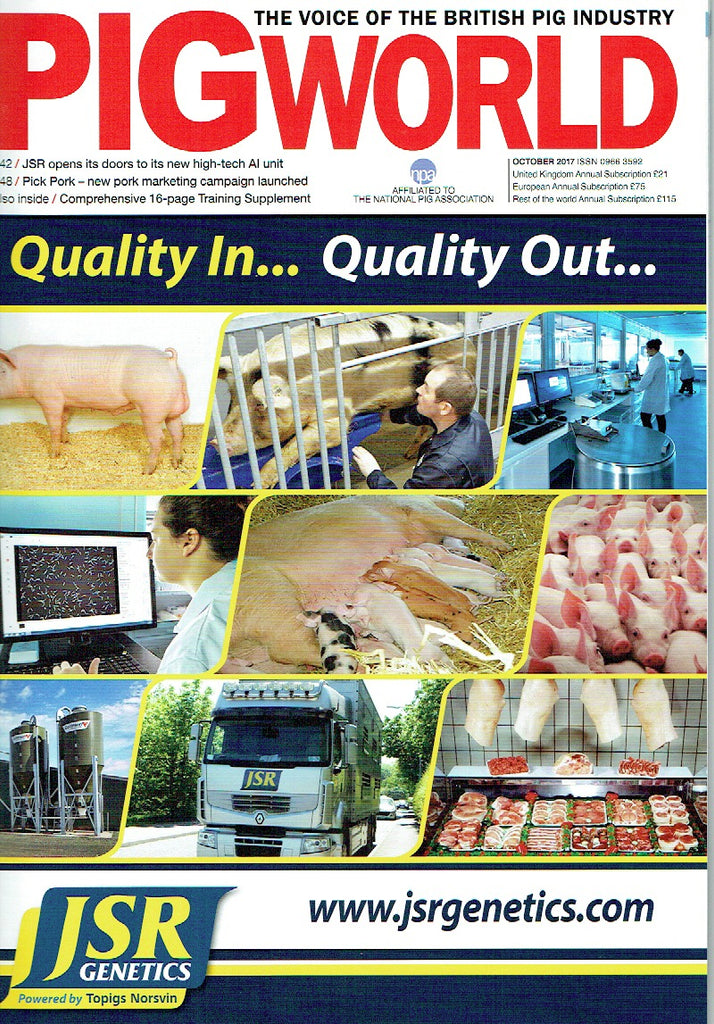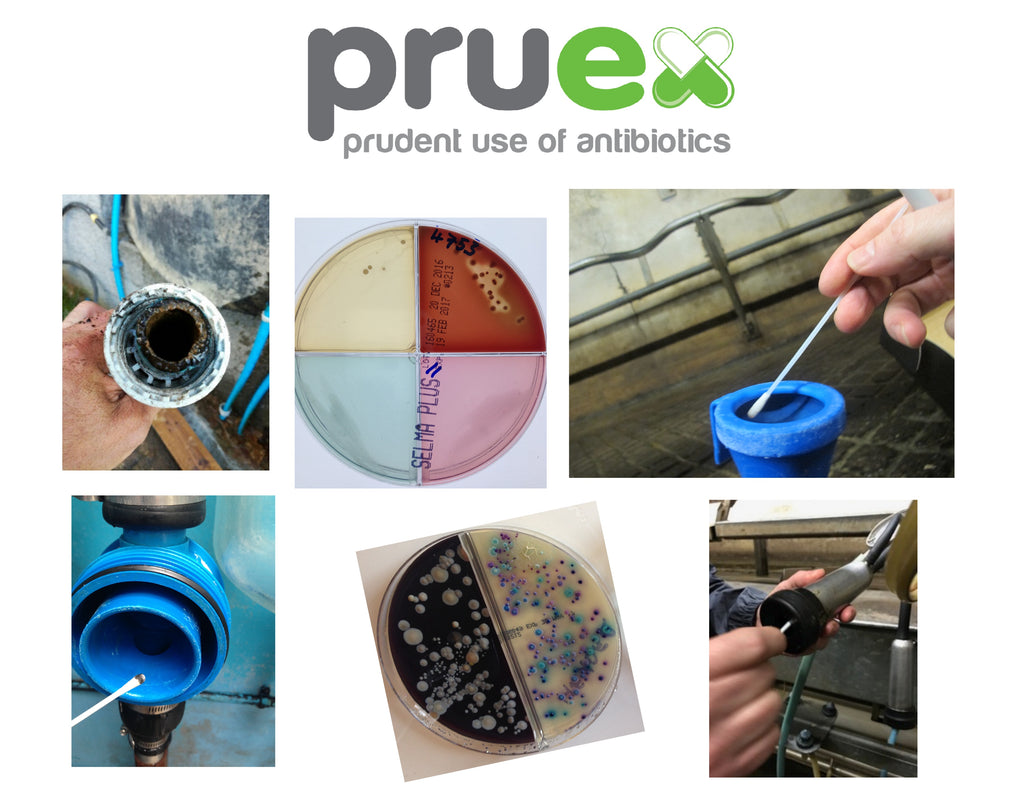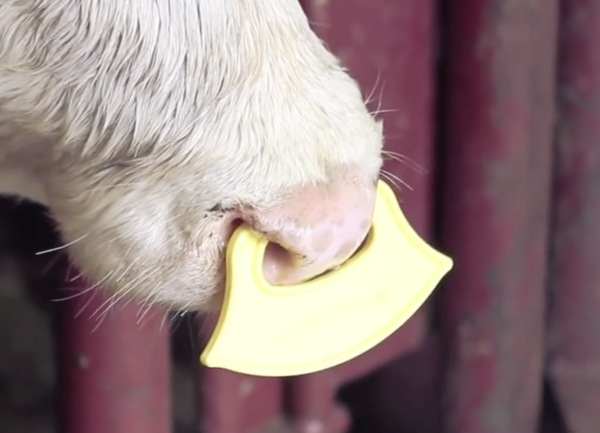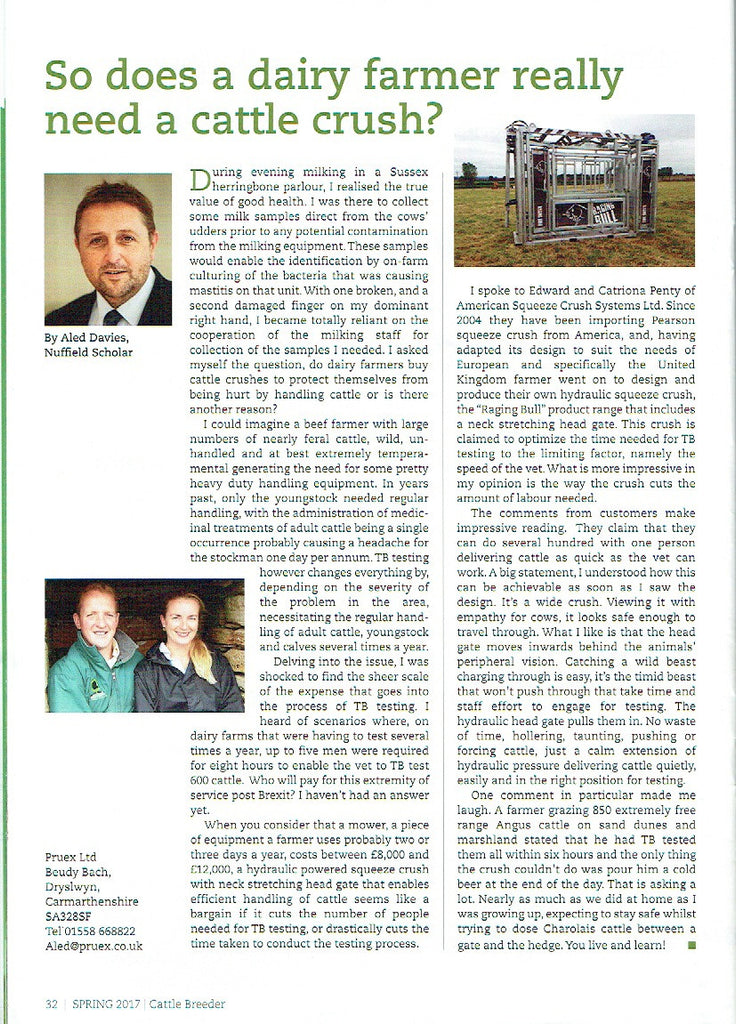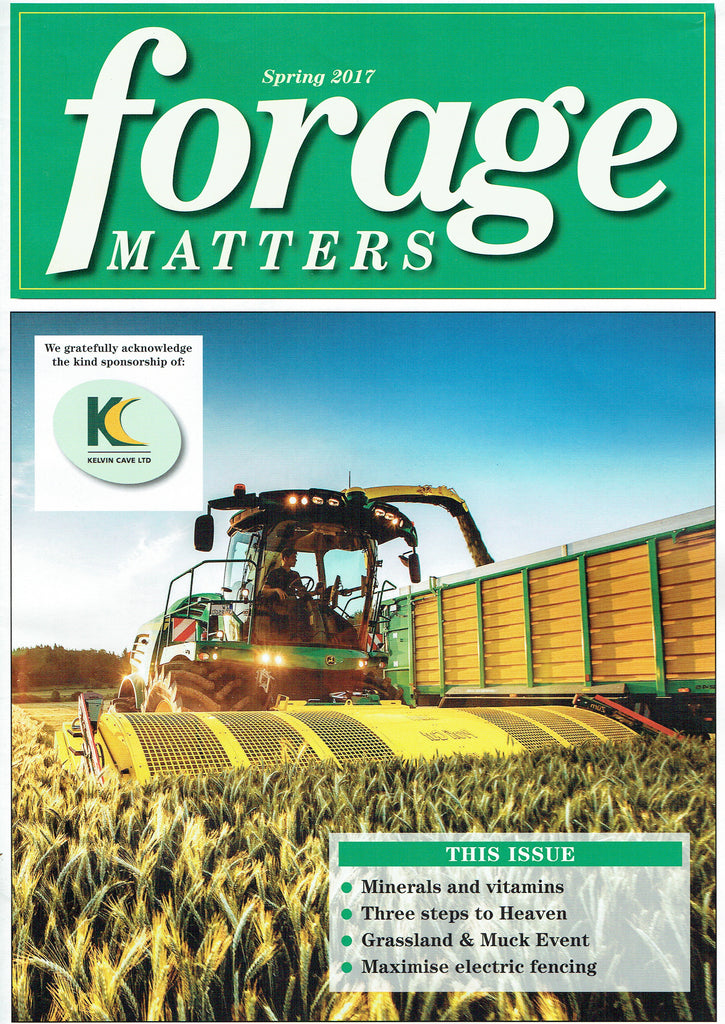News
Somatic cell count increases in summer
Today at the British Mastitis Conference workshop held at the Sixways Stadium in Worcester, I became aware of the regularity of increases in Soamtic Cell Counts (SCC), encountered on numerous dairy farms during the months of British summer time.
Several case studies were presented by those that deliver "Mastitis Control Plans" which analyse and examine both SCC data and clinical mastitis records to diagnose the cause of mastitis for their farmer clients. A reoccurring theme was one of increasing SCC at a time of year when the omega 3 content of pasture is at it's highest. No real explanation was derived as to why this should be the case. On reflection, my thoughts turned to my study of Valorex, a feed compounder in France, during my Nuffield study into antibiotic use in agriculture. This company extrude Linseed to enable better absorption of the Omega 3 fats contained within.
Bleu-Blanc-Coeur is a brand that Valorex communicate the health benefits of increased Omega 3 fats in end products such as cheese, milk and meat to consumers. Farmers get a premium for their livestock or milk outputs if they feed a ration including extruded linseed, and hence influence the quality of the end produce they market. I wasn't in France however to examine the premium achieved in the value chain, I was there to examine the health benefits of manipulating the Omega 3 : Omega 6 ratio through feeding extruded linseed. The work done by Valorex showed that by manipulating the Omega fat ratios, there was also a manipulation of the progesterone : prostaglandin ratio in favour of increased immune response. So, by feeding extruded linseed, and hence increasing the efficacy of immune response, animals are better able to deal with infections.
A similar increase in Omega 3 is witnessed naturally when animals consume spring and early summer pastures rich in Omega 3. Their immune function is known to increase as a result.
A nagging thought that I'll need to further examine is based on this increased immune efficacy at the beginning of summer. Are cow immune responses unable to cope with udder infections until increased Omega 3 rations delivered naturally in spring? Is that why there is an increase in SCC during summer months whilst during the same period clinical mastitis cases in dairy cows measured by those presenting at the conference remain stable? In other words, are the cows udders infected, but the cows can't fight the infection until the increased Omega 3 in their diets allow them to do so? If so, why don't we manipulate Omega 3 favorable diets throughout the year as they do in France?
For Farmers, an European feed manufacturer offer extruded linseed in the UK. I think I'll go and speak to them.
Are our farming practices capitalizing on sick animals? Pig World Article


In October 2014, I was delighted to be awarded a 2015 Nuffield Farming Scholarship, sponsored by the Royal Welsh Agricultural Society, to study “Alternatives to antibiotics in Agriculture”. I looked at production systems in Aquaculture, pig, poultry layers, poultry broilers, dairy, beef and sheep sectors in Europe, Pacific Rim countries and Northern America. What I learned by studying fish farming opened a “can of worms” that allowed me to dig down into the issues on farm for each species that cause the need for antibiotics. My findings changed my career path, changed the way I looked at the problem of resistant bacteria, and led to the incorporation of Pruex Ltd to take the lead in the fight against Anti-Microbial Resistance.
In Norway, I learned that fish farmers can sell sick fish, but can’t sell dead fish. Rather than stimulate immunity to help fight infections in their fish, they feed a high saturated fat diet with the aim of suppressing immunity. This thinking was “Upside down” for me. By lowering the immune response, their fish suffer from less inflammation of vital organs, and as a result, mortality decreases. The fish are still infected, but ultimately make the marketplace.
I kept asking myself the same old questions: Is the pig industry different to aquaculture? Do the pigs with the strongest immune response just fall down dead due to inflammation? Should we be suppressing our pigs’ immunity to keep them alive as opposed to stimulating the immunity to fight off infections?
Whilst studying Broiler Chicken production in Canada, I explained to an experienced operator how, in the UK, at the end of every crop we wash, use detergent, disinfectant, fog, mist, and even burn our surfaces ahead of re population with the next crop. He obviously thought I was mad to suggest such a protocol. He explained that they clean their building once a year. I thought he was mad to put a new crop of chicks on the previous crops litter. He calmly replied, that if you have good bacteria in your shed, don’t kill it. I had no idea at that point what he meant, but I kept asking myself some pretty fundamental questions: Why if animals don’t live is sterile conditions do we attempt to disinfect the environments we keep them in? How do you know if you have good bacteria in your shed? If we disinfect our farm animals’ environments, how do they still manage to get sick?
The large farming companies I studied that achieve premiums by differentiating their end market meat products by claiming “Raised without antibiotics”, or “No Antibiotics ever”, all had one thing in common. They knew exactly which bacteria were causing infections in their animals. They take swabs of surfaces, culture and identify the infective bacteria in their animals’ environments and water sources. They modulate their hygiene protocols accordingly, and reduce the need for antibiotics by limiting infections. The evidence they generated on farm enabled them to limit infections. They didn’t assume that disinfection at certain times in their production cycle controlled the amount of infective bacteria their animals face. They assumed that the bad bugs overcome disinfection. They measured the potential risks their animals faced.
I started Pruex Ltd, Prudent not excessive antibiotic use, to help farmers in the UK do the same. We train farmers to swab, culture and incubate bacteria present in their animals’ environments. This allows them to modulate their hygiene protocols to limit the risk of infection on their farm. Typically farmers comment that there is no point swabbing a certain farrowing building as it was recently disinfected. The results of such swabs clearly demonstrate the presence of biofilm, that is, the nest of bad bacteria that survive disinfection to go on and re-populate the void generated by the cleaning process. In other words, we kill off both good and bad bacteria by cleaning, and allow the tough bad ones that are hidden away in biofilm to repopulate our surfaces and water sources. Farmers are amazed at the level of E.Coli and other nasties present in the biofilm that populate the insides of their water pipes, drinking nipples, disinfected heat pads, and slats.
Fig.1 Extreme biofilm in water pipes from Borehole. Copyright Pruex Ltd
To keep young animals healthy, water quality is paramount. I certainly wouldn’t want to drink water from a pipe with such a putrid biofilm as the example in Fig.1. And wouldn’t like my piglets to drink it either. There’s no wonder piglets scour if they drink water containing infective bacteria fuelled by biofilm. Farmers get quite angry when they realize that their water sanitation systems only suppress biofilm in their water pipes and don’t totally remove it.
Once we know which bacteria are causing infections in pig buildings, we help farmers ensure that their buildings are dominated with non-infective bacteria. Rather than attempt to kill all bacteria, we populate their environments with non-infective bacteria. This reduces the infective bacteria challenge the animals face.
The culture plates in Fig.2 illustrate the importance of generating evidence of the source of infection. It shows good bacteria being dominant in both the farrowing building (Farr) and the flat decks (FD). The middle plate (FD Water) shows small putrid smelling green colonies of infective bacteria present in the water the weaned pigs have to drink. The water itself is treated with Chlorine Dioxide, but the water the pigs drink is contaminated by biofilm at the point of drinking. Mortality in this building is high. The pigs are fed a medicated ration, which no doubt kills non-infective bacteria in the animal’s gut, which is probably replaced, by the putrid bacteria in the water source. The assumption was always that the water was clean because it was disinfected.

Fig. 2 Culture Plates Copyright Pruex Ltd
Pruex use good or non-infective bacteria to limit the dominance of bad or infective bacteria in our farm animals’ environments. We educate and train farmers in the use of on farm culturing as a means of generating evidence of infective bacterial challenge. We tell consumers of the good work done in agriculture to limit Anti-Microbial Resistance. As an industry, we need consumers to understand that human misuse of antibiotics, as opposed to a misuse in agriculture is responsible for the escalation of Anti-Microbial Resistance.
Typically farmers comment that applying non-infective bacteria to water and surfaces, and swabbing, culturing and incubating cost more than just disinfecting, but farming animals that aren’t sick and don’t require medicated feed is worth it. I do think that as an industry we are farming sick pigs, but recognize that based on evidence we can limit the need for antibiotics on our farms and keep truly healthy animals. I started Pruex to help.

If you want to take bacterial loading pressure off your pigs by cleaning their water pipes, then contact Pruex.
Aled Rhys Davies.
A "New" antibiotic for Staph Aureus in Dairy Cows
At the Welsh Dairy Event in Carmarthen, we have learned of a "new" antibiotic available to our vets from a company in Belgium. Albiotic has a claim for Staph Aureus.
It is important that we as an industry respect this technology by using it prudently as opposed to excessively.
Pruex can help. Our on farm culture package allows farmers to identify which bacteria is causing an infection. Typically within 24 hours, a bacterial infection can be identified. A sample of milk is taken by the farmer from an infected quarter. This is plated, incubated for 24 hours and the results analysed. If the "bug" is Staph Aureus, your vet can advise you if you should use this new antibiotic to treat.
The plate shows Staph Aureus bacteria. Farmers can use the book that comes with the pack to identify the "bug".
Water quality and scouring calves
At the Welsh Dairy event in Carmarthen October 24th 2017, Pruex founder Aled Rhys Davies will be discussing water quality and its influence on the health of young calves.
"Often, as farmers we concentrate on adaptive immunity, colostrum quality, and vaccinations whilst forgetting the role of inert immunity" Says Aled. "The bacterial environment and content of early rations which include water sources are instrumental in the young calves defence mechanisms, often for the rest of their lives."
If you use borehole water, and have slime in your water pipes, then a visit to Pruex at the show could help you keep your calves healthy.
Dairy Cow antibiotic reduction conference a must for the professional dairy farmer.
December the 7th, at the Royal Bath & West Showground, Aled Rhys Davies, Managing Director of Pruex Ltd will be one of the speakers at the innovation for agriculture dairy cow antibiotic reduction conference. So, he’ll need to get out of his overalls, stop his farm visits, forget his lab coat and his laboratory work and concentrate on the dissemination of what he has learned since the completion of his Nuffield Farming Scholarship on Alternatives to Antibiotics in Agriculture.
When asked about the challenges farm animals face, Aled commented, “At the start of my Nuffield study, I had very little recollection of the difference between innate and adaptive immunity. That was probably a good thing as I found myself asking some pretty basic questions to some pretty impressive people. The result being a truly balanced, non commercially biased impression as to what agriculture needs to do to reduce stress in the form of bacterial loading on our farmed animals.”
Pruex works with farmers to develop evidence as to where bacterial infections occur in their animals. “Once farmers know why they need to change some practices on their farms, they are brilliant at working out how to do so. Pruex helps them decide on how to limit infection pressure”, claims Aled.
To avoid financial penalties from elevated Somatic Cell Counts in milk, farmers will often hold milk from problem cows back from the bulk tank. Whilst a short term fix, this strategy certainly doesn’t get at the heart of the problem. At the conference, Aled will offer some practical alternatives that farmers can use to prevent the infection of cows udders in the first place. “Contamination of milk by sick cows is a problem that will only escalate unless we start the process of fixing now. To do so, farmers need evidence of what needs changing to prevent sick cows. Attending the conference would be a good place to start,” said Aled.
Further details including booking forms are available from the organisers
You know that the stress of weaning can make young cattle sick.
You no longer have to feel helpless in the fight against infections that arise in young cattle triggered by stressful weaning. In Canada, a simple nose tag has been developed to reduce weaning stress. The calf is fitted with a Quiet Wean nose tag. It prevents it from suckling, but it still has the comfort of it's mothers company. Around a week later, the tag is removed as the calf is weaned. They seem to cope with loosing their mother far better. They don't loose mother and milk on the same day. The video below explains the science.
Reared without antibiotics - The start of communication
I’m Aled Rhys Davies, the Managing Director of Pruex Ltd, and today am delighted to be cooking breakfast using a very special type of bacon. The Spoilt Pig brand is the first I know of, distributed by retailers, to claim the status of “Reared without Antibiotics”. The pigs used are kept to a high welfare standard with the aim of preventing infections and illness, so that the need to treat sick animals with antibiotics if the infection is bacterial is negated. Any animal that is treated with antibiotics at any stage of its life is marketed under a different brand. The Spoilt Pig brand therefore offers consumers choice in their purchases.

Within the United Kingdom, if an animal is sick as a result of a bacterial infection, then from a welfare and often a legal point of view, it is rightly treated with an antibiotic to stop it from suffering. The food chain is safe from Antibiotic residues due to strict testing protocols and withdrawal periods for antibiotic treated meat.
Todays fare includes, pork sausages, a fried egg, fried bread and tomatoes. Whilst the sausages might be from animals treated with antibiotics, I’m happy to eat them, as there won’t be antibiotic residues in them nor the egg to cause me any trouble. There is more chance of contracting infective bacteria, resistant or not to antibiotics, from raw meat than from cooked.
The reason I’m delighted to use the Spoilt Pig brand is that it’s a tangible start in the process of communicating to consumers the great work done in agriculture to limit Anti Microbial Resistance. The farms that supply pigs for other brands also work hard to ensure that their animals are not infected by disease causing bacteria. They go to great lengths to ensure the water their animals drink is clean of infective bacteria, their animals are well sheltered outside, or are housed in clean, spacious, well ventilated accommodation, and dedicate a large amount of time and effort towards ensuring their animals remain healthy. There is no chance of securing financial prosperity whilst farming sick animals. Agriculture as an industry needs to build on the example set by the Spoilt Pig brand, and look to further communicate good practice in husbandry and hygiene to consumers. Pruex look forward to helping in the process.
A note to Consumers:
- Giving sick animals that are infected with disease causing bacteria an antibiotic is good. It constitutes Prudent as opposed to Excessive antibiotic use. It is Pruex.
- Giving sick animals that are infected with a virus an antibiotic in not good. It is not Prudent use. It is not Pruex.
- To limit Anti Microbial Resistance, that is, bacteria that are resistant to our medicines and cleaners, we all have to do our bit. We are all in this together, rich, poor, young, old, weak, strong, animals, humans.
Action for consumers:
- If you have a sore throat, don't insist on an antibiotic from your doctor. He or she might inform you that your infection is caused by a virus. If they say it's bacterial, then use the antibiotic they prescribe. You will be Pruex.
Are we infecting our cows every time we milk?
Somatic Cell Counts per ml of milk indicate an immune response to an infection. Yet the inside of the udder is supposed to be a sterile environment. So, does a cow with 50,000 cells per ml of milk really have a low cell count? Should we be striving for zero cell counts per ml?
Work done by Pruex shows that cows teats maintain a high level of mastitis causing bacteria on their surfaces throughout the milking process regardless of teat preparation protocol or wether or not the cows are milked by robot, parlour, or if the apparatus have a back flush system or not. The teats pre preparation for milking are not clean of infective bacteria even though they have had a chemical disinfectant applied post the previous milking. Mastitis causing bacteria are present on the teats when the process of milking takes place, when the teat is surrounded by nice warm milk. The ultimate result is the need for antibiotics to treat the resulting clinical cases of mastitis.

Pruex work with farmers to evaluate the level of potential for infection their teat cleaning protocols produce. By knowing where in the process the cows are getting infected, farmers can use evidence to form prudent as opposed to excessive antibiotic use strategies for their cows. In other words, they can work out the best way to limit the risk of infection by bacteria of their cows' udders during the process of milking.
All too often we assume that the cows teats are clean because we use disinfectant teat dips or sprays. If you want to check this assumption out on your farm, please contact us. Info@pruex.co.uk
Does a Dairy farmer need a cattle crush?
During evening milking in a Sussex herringbone parlour, I realised the true value of good health. I was there to collect some milk samples direct from the cows’ udders prior to any potential contamination from the milking equipment. These samples would enable the identification by on-farm culturing of the bacteria that was causing mastitis on that unit. With one broken, and a second damaged finger on my dominant right hand, I became totally reliant on the cooperation of the milking staff for collection of the samples I needed. I asked myself the question, do dairy farmers buy cattle crushes to protect themselves from being hurt by handling cattle or is there another reason?

I could imagine a beef farmer with large numbers of nearly feral cattle, wild, un-handled and at best extremely temperamental generating the need for some pretty heavy duty handling equipment. In years past, only the youngstock needed regular handling, with the administration of medicinal treatments of adult cattle being a single occurrence probably causing a headache for the stockman one day per annum. TB testing however changes everything by, depending on the severity of the problem in the area, necessitating the regular handling of adult cattle, youngstock and calves several times a year.
Delving into the issue, I was shocked to find the sheer scale of the expense that goes into the process of TB testing. I heard of scenarios where, on dairy farms that were having to test several times a year, up to five men were required for eight hours to enable the vet to TB test 600 cattle. Who will pay for this extremity of service post Brexit? I haven’t had an answer yet.
When you consider that a mower, a piece of equipment a farmer uses probably two or three days a year, costs between £8,000 and £12,000, a hydraulic powered squeeze crush with neck stretching head gate that enables efficient handling of cattle seems like a bargain if it cuts the number of people needed for TB testing, or drastically cuts the time taken to conduct the testing process.
I spoke to Edward and Catriona Penty of American Squeeze Crush Systems Ltd. Since 2004 they have been importing Pearson squeeze crush from America, and, having adapted its design to suit the needs of European and specifically the United Kingdom farmer went on to design and produce their own hydraulic squeeze crush, the “Raging Bull” product range that includes a neck stretching head gate. This crush is claimed to optimize the time needed for TB testing to the limiting factor, namely the speed of the vet. What is more impressive in my opinion is the way the crush cuts the amount of labour needed.
The comments from customers make impressive reading. They claim that they can do several hundred with one person delivering cattle as quick as the vet can work. A big statement, I understood how this can be achievable as soon as I saw the design. It’s a wide crush. Viewing it with empathy for cows, it looks safe enough to travel through. What I like is that the head gate moves inwards behind the animals’ peripheral vision. Catching a wild beast charging through is easy, it’s the timid beast that won’t push through that take time and staff effort to engage for testing. The hydraulic head gate pulls them in. No waste of time, hollering, taunting, pushing or forcing cattle, just a calm extension of hydraulic pressure delivering cattle quietly, easily and in the right position for testing.
One comment in particular made me laugh. A farmer grazing 850 extremely free range Angus cattle on sand dunes and marshland stated that he had TB tested them all within six hours and the only thing the crush couldn’t do was pour him a cold beer at the end of the day. That is asking a lot. Nearly as much as we did at home as I was growing up, expecting to stay safe whilst trying to dose Charolais cattle between a gate and the hedge. You live and learn!
Is there more value than just forage in a grassy field?
Since conducting a Nuffield Farming Scholarship looking at "Alternatives to Antibiotics in Agriculture" I've come to realise that fields are more than a source of forage for livestock. They are a maternity ward, a crèche, a toilet, a restaurant, a pharmacy and a bed. The balance of these variables can affect output. If we maintain stocking rates that pollute grazing with faeces then the value of feed intake is compromised. We expect our animals to maintain a high degree of health whilst at pasture and spend a considerable amount of hard earned cash purchasing and administering animal health products to maintain a level of acceptable output from our livestock assets. We however are often the cause of the need for these products. Our husbandry can upset the balance resulting in sick animals.
We concentrate nutrients out of balance. We graze animals on crops of red clover, we supplement their feed with fodder beet and high polyunsaturated fat content rye grass silage or out winter on kale and then wonder why our cows hold on to their afterbirth. These crops contain goitrogens that inhibit iodine uptake by the thyroid gland. Getting iodine into these cows to address the balance can be done in many ways. Feeding kelp seems to be a great way of doing so. There are other ways, but we need to know that a balance must be achieved to maintain healthy animals.
Stocking rate increases have also upset the balance of our maternity wards. Intensification and increased numbers of animals per hectare has seen us as farmers calving, lambing, farrowing and hatching indoors, or under increased pressure in dedicated paddocks outside. As a result, animals such as calves land on surfaces infested by a cocktail of some pretty infective bacteria. A soup of wet muck covered over by a thin layer of supposedly clean straw. Their umbilical cords would not be subjected to such infestation in the wild. Yes, there would probably be e.coli pasteurella, klebsiella and other infective bacteria in a natural field environment, but these would be out numbered by non-infective bacteria. From the moment these calves injest colostrum, it take three days for their adaptive immunity to develop. This is the type of defence that protects them from bacterial infections. In my discussions with dairy farmers, I've learned that calf scour is considered normal. They have the same number of calving pens for four hundred cows as they did when they had one hundred.

Another variable out of balance is the amount of work done on farm compared to the financial returns achieved. We seem, as an industry, to be busy increasing the numbers of animals we keep with less and less staff and for less return per unit of production. The big stress escalator being the dreaded occurrence of disease outbreak.
One of the big things I learned on my Nuffield was that the health of the young animal determines it's lifetime production output. Sick smolt salmon never grow as well when they get to the sea cages, piglets that scour struggle to finish with the rest of the batch, sick lambs struggle to survive. The animal health products we buy such as antibiotics limit the effect of an infection. It seem to me that we need to start working on limiting the infection from taking hold in the first place. To do so, we have to generate evidence as to what we have out of balance.



